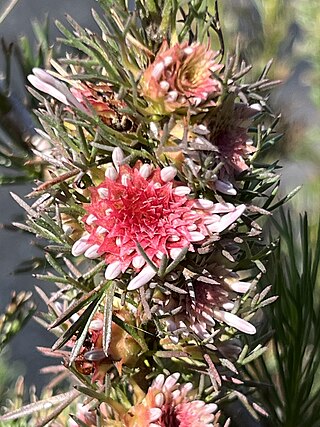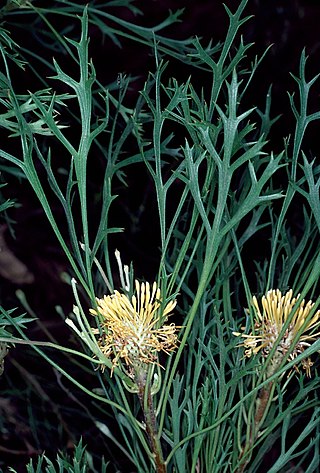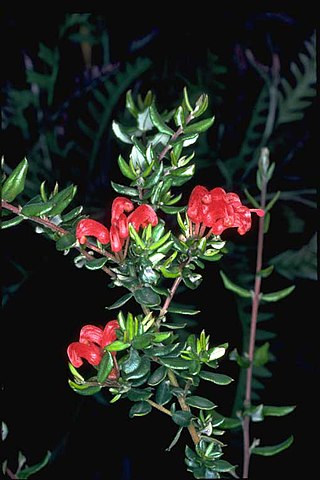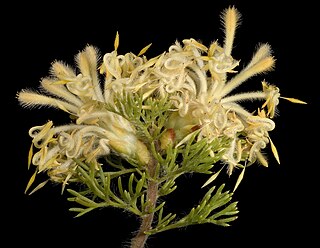Related Research Articles

Banksia biterax is a species of dense shrub that is endemic to Western Australia. It has hairy stems, deeply serrated leaves and spikes of up to 200 pale to dark brown flowers.
Robert Brown's taxonomic arrangement of Banksia was published in his book of 1810, Prodromus Florae Novae Hollandiae et Insulae Van Diemen, and expanded in the supplement to that publication, Supplementum Primum Prodromi Florae Novae Hollandiae, in 1830. It was the first survey of Banksia species to be published, and included descriptions of a number of previously undescribed species.
Prodromus Florae Novae Hollandiae et Insulae Van Diemen is book dealing with the flora of Australia written by botanist Robert Brown and published in 1810. Often referred to as Prodromus Flora Novae Hollandiae, or by its standard botanical abbreviation Prodr. Fl. Nov. Holland., it was the first attempt at a survey of the Australian flora. It described over 2040 species, over half of which were published for the first time.
Robert Brown's taxonomic arrangement of Dryandra was the first arrangement of what is now Banksia ser. Dryandra. His initial arrangement was published in 1810, and a further arrangement, including an infrageneric classification, followed in 1830. Aspects of Brown's arrangements can be recognised in the later arrangements of George Bentham and Alex George.

Isopogon dubius, commonly known as pincushion coneflower, is a species of plant in the family Proteaceae and is endemic to the south-west of Western Australia. It is a shrub with sharply-pointed, deeply lobed or pinnate leaves and more or less spherical heads of pink to reddish pink flowers.

Petrophile linearis, commonly known as pixie mops, is a species of flowering plant in the family Proteaceae and is endemic to southwestern Western Australia. It is a shrub with narrow egg-shaped leaves, the narrower end towards the base, and oval to spherical heads of hairy, greyish-pink or mauve to almost white flowers.

Petrophile canescens, commonly known as conesticks, is a species of flowering plant in the family Proteaceae and is endemic to eastern Australia. It is an erect shrub with pinnately-divided leaves and oval heads of hairy, white to pale cream-coloured flowers.

Isopogon asper is a species of plant in the family Proteaceae and is endemic to the south-west of Western Australia. It is a low shrub with crowded pinnate leaves and flattened spherical heads of glabrous pink flowers.

Persoonia fastigiata is a plant in the family Proteaceae and is endemic to the Northern Tablelands of New South Wales. It is a small, erect to spreading shrub with linear leaves and hairy flowers arranged singly or in groups of up to five on a rachis up to 10 mm (0.39 in) long.

Persoonia curvifolia is a plant in the family Proteaceae and is endemic to central New South Wales. It is an erect to spreading shrub with linear leaves and somewhat hairy yellow flowers.

Persoonia tenuifolia, commonly known as fine-leaf geebung is a plant in the family Proteaceae and is endemic to eastern Australia. It is an erect to low-lying shrub with hairy young branchlets, linear leaves, and yellow flowers in groups of up to eight on a rachis 2–30 mm (0.079–1.181 in) long that continues to grow after flowering.

Persoonia microphylla is a plant in the family Proteaceae and is endemic to New South Wales. It is an erect to prostrate shrub with elliptic to egg-shaped leaves and yellow flowers in groups of up to fourteen on a rachis up to 30 mm (1.2 in) long.

Grevillea triternata is species of flowering plant in the family Proteaceae and is endemic to New South Wales. It is a dense, compact shrub with divided leaves, the end lobes sharply pointed, linear to narrowly triangular, and cylindrical clusters of white flowers with a cream-coloured to pale yellow style.

Isopogon baxteri, commonly known as the Stirling Range coneflower, is a species of plant in the family Proteaceae and is endemic to the south-west of Western Australia. It is an erect shrub with wedge-shaped, often 3-lobed, toothed leaves and flattened spherical heads of hairy pink flowers.

Isopogon divergens, commonly known as spreading coneflower, is a species of plant in the family Proteaceae and is endemic to the south-west of Western Australia. It is a shrub with pinnate leaves and more or less spherical heads of glabrous pink flowers followed by an oval to cylindrical fruiting cone.

Isopogon petiolaris is a species of plant in the family Proteaceae and is endemic to eastern Australia. It is a low, spreading shrub with sharply-pointed, divided leaves and more or less spherical heads of yellow flowers.

Grevillea depauperata is a species of flowering plant in the family Proteaceae and is endemic to the south-west of Western Australia. It is a low, dense, spreading shrub with oblong or egg-shaped leaves and clusters of red to orange flowers.

Petrophile anceps is a species of flowering plant in the family Proteaceae and is endemic to a restricted part of southwestern Western Australia. It is a shrub with sharply-pointed, linear leaves and oval heads of hairy yellow flowers.
Petrophile phylicoides is a species of flowering plant in the family Proteaceae and is endemic to southwestern Western Australia. It is a shrub with short, needle-shaped, but not sharply-pointed leaves, and more or less spherical heads of glabrous yellow flowers.

Petrophile serruriae is a species of flowering plant in the family Proteaceae and is endemic to southwestern Western Australia. It is a shrub with crowded, pinnate, needle-shaped, sharply-pointed leaves, and oval heads of silky-hairy yellow, greyish mauve to pink flowers.
References
- ↑ "Supplementum Primum Prodromi Florae Novae Hollandiae". International Plant Names Index (IPNI). Retrieved 30 March 2007.